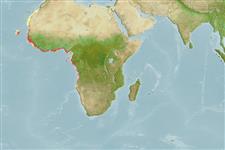Elasmobranquios (tiburones y rayas) (sharks and rays) >
Myliobatiformes (Stingrays) >
Zanobatidae (Panrays)
Etymology: schoenleinii: Needs a better reference..
More on authors: Müller & Henle.
Environment: milieu / climate zone / depth range / distribution range
Ecología
marino demersal; rango de profundidad ? - 100 m (Ref. 27000), usually 10 - 15 m (Ref. 114953). Tropical; 31°N - 18°S, 19°W - 14°E (Ref. 114953)
Eastern Central Atlantic: Morocco to Angola.
Length at first maturity / Tamaño / Peso / Age
Maturity: Lm 38.5, range 37 - 40 cm
Max length : 100.0 cm TL macho / no sexado; (Ref. 6513); common length : 40.0 cm TL macho / no sexado; (Ref. 114953); common length :50 cm TL (female); peso máximo publicado: 1.4 kg (Ref. 114953)
Occurs in shallow coastal waters to moderate depth, over sandy and sandy-muddy bottoms. Feeds on mollusks and other benthic invertebrates, mainly shrimps (Ref. 6513, 114953). Ovoviviparous (Ref. 5377). Females mature at 37-40 cm TL, males ca. 30 cm TL; born at ca. 19 cm TL. Litters of 1-4 pups after short gestation; born at ca. 19 cm TL (Ref. 114953).
Life cycle and mating behavior
Madurez | Reproducción | Puesta | Huevos | Fecundidad | Larva
Exhibit ovoviparity (aplacental viviparity), with embryos feeding initially on yolk, then receiving additional nourishment from the mother by indirect absorption of uterine fluid enriched with mucus, fat or protein through specialised structures (Ref. 50449).
Stehmann, M., 1990. Platyrhinidae. p. 28. In J.C. Quero, J.C. Hureau, C. Karrer, A. Post and L. Saldanha (eds.) Check-list of the fishes of the eastern tropical Atlantic (CLOFETA). JNICT, Lisbon; SEI, Paris; and UNESCO, Paris. Vol. 1. (Ref. 6513)
IUCN Red List Status (Ref. 130435)
Threat to humans
Harmless
Human uses
Pesquerías: comercial
Más información
Age/SizeCrecimientoLength-weightLength-lengthLength-frequenciesMorfometríaMorfologíaLarvaDinámica larvariaReclutamientoAbundanciaBRUVS
ReferenciasAcuiculturaPerfil de acuiculturaRazasGenéticaElectrophoresesheritabilidadEnfermedadesProcesamientoNutrientsMass conversion
Herramientas
Special reports
Download XML
Fuentes de Internet
Estimates based on models
Preferred temperature (Ref.
123201): 15.6 - 20.9, mean 19.2 °C (based on 19 cells).
Phylogenetic diversity index (Ref.
82804): PD
50 = 0.7500 [Uniqueness, from 0.5 = low to 2.0 = high].
Bayesian length-weight: a=0.01000 (0.00244 - 0.04107), b=3.04 (2.81 - 3.27), in cm total length, based on all LWR estimates for this body shape (Ref.
93245).
Nivel trófico (Ref.
69278): 3.6 ±0.44 se; based on food items.
Resiliencia (Ref.
120179): Bajo, población duplicada en un tiempo mínimo de 4.5-14 años (Fec assumed to be <100).
Fishing Vulnerability (Ref.
59153): High vulnerability (60 of 100).
